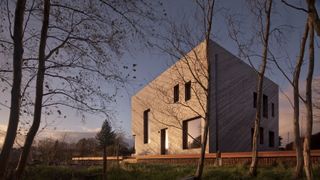This Stylish Passivhaus was Self-Built for Just £250k
Martin McCrae and Mhairi Grant took the meaning of ‘self build’ literally and built their contemporary Passivhaus on a DIY basis

After working on a substantial renovation and extension for her parents, Mhairi and her husband Martin, founders ofPaper Igloo Architecture, looked to their own home — a renovated flat in Glasgow that they couldn’t get above 16ºC in winter. It was clear a new home was on the horizon for them.
“Self build felt like the natural choice for us because we’ve always been quite hands on,” says Mhairi. "Being self-employed we just thought we also needed to be mortgage free, have fewer bills and make our cost of living more manageable.
“The idea to build aPassivhauscame before we found the plot. It was something we were absolutely intent on from the beginning and at that point in time I had just completed a taster course on Passivhaus design to get a feel for what was involved.”
Here, the couple outline how they created their green home on a budget.

1. Balance a Striking Design with DIY Efforts
“Once we found the plot the design for the house unfolded. The plot is relatively long and narrow so it led us to a more compact square shape,” explains Mhairi, who took the lead on the project. An essential aspect of successfully building the contemporaryself buildin the country was for Mhairi and Martin to take on much of the work on a DIY basis to keep to their tight budget.
“We used contractors to dig out the site and put in the sub-base and below-ground drainage,” continues Mhairi. “Then we took a long weekend and installed the insulated raft foundation system before a different contractor poured the concrete slab that would be our ground floor finish.
"From there Martin and two joiners stick-built thetimber frame construction. After the 12 weeks were over, the joiners left and it was just Martin and I. We installed all of the insulation, the plasterboard, the cladding, plumbing and internal joinery. The only people that came in to help were a ventilation specialist for the MVHR system and an electrician.”

“Motivation was the main challenge,” adds Martin. “After a day of work, the last thing you want to do is pick up tools and work for four hours in the evening, especially through the winter. But we learned to break it down into small portions and jobs at a time. There was a lot of sacrifice in terms of social events missed and seeing friends.
“The other big challenge was the weather. It took four years to do thetimber claddingas we had to wait for the nicer weather and had to do quite a lot of temporary protection during the winter. Because the cladding was diagonal it was really time-consuming to do because of the complicated compound mitres, so every summer we would clad an elevation.”
总之,这个项目花了马丁和Mhairi 6years to complete. They decided once the house was weathertight to move from their chilly caravan on site and to camp in the house with one bathroom plumbed in.

2. Deliver a Truly Green Build
Even more impressive, however, was the couple’s dedication to a truly green build. After looking at many plots around the central belt of Scotland, the couple found a narrow strip of land in the small village, with many homes heated by coal or oil. “I couldn’t believe my eyes when the coal man first turned up in the village with a delivery,” says Mhairi. “We knew we would have to be all-electric so that was another motivation for going Passivhaus.”
They limited their waste on the project too to such a degree that no skips were used on site, with scraps of plasterboard and wood fibre saved and reused and scrap larch from the cladding sent to fuel Mhairi’s dad’s woodburner.
“你必须训练有素和packa之类的东西ging — everything comes wrapped in plastic,” says Martin. “We separated things out into piles of materials and decided what to get rid of and what could be recycled or repurposed. We also had a keen eye on quantities. For us, it was part of the ethos of building a sustainable home — we had to be sustainable in the way we did it.”
(MORE:Ways to use less plastic in your build project)

Achieving Passivhaus standards is quite the achievement for first-time builders on a DIY basis and is no doubt thanks to the their patience and attention to detail throughout. “We actually quite enjoyed doing theairtightnessmembrane DIY,” admits Mhairi. “It was one of my favourite bits of the build because it also requires you to be methodical and neat and those are traits that a lot of self builders have but where trades might put less time into. Now that we’re in, the whole thing was worth it!”
“It has been fabulous living in the house and has exceeded our expectations,” Martin concludes. “We’re so lucky — the views are amazing and the house is so comfortable and warm.”


3. Create a Central Layout with a Statement Feature
“When it came to finalising the layout I did a bit of 3D modelling for different looks for the building with different colour schemes and materials until we settled on the one we wanted,” says Martin. The duo settled on a black central core around which the layout flows.
“There’s a bit of black box in every room — as well as the stairs, it contains all the plumbing for the bathrooms and kitchen,” adds Mhairi. “All of the rooms that require sunlight are all around the perimeter of that so you get a nice contrast between the sculptural but functional box and views to the outside.”
As the house has no loft or garage, storage was essential to build in around the layout. The first five stair treads open for hidden cupboards and a secret gin cabinet can be found in the kitchen.
Get the Homebuilding & Renovating Newsletter
Bring your dream home to life with expert advice, how-to guides and design inspiration, direct to your inbox.
Assistant Editor Amy began working for Homebuilding & Renovating in 2018. She has an interest in sustainable building methods and always has her eye on the latest design ideas. Amy has interviewed countless self builders, renovators and extenders about their experiences for Homebuilding & Renovating magazine. She is currently renovating a mid-century home, together with her partner, on a DIY basis, and has recently fitted her own kitchen.
Bring your dream home to life with expert advice, how-to guides and design inspiration, direct to your inbox.
Thank you for signing up to Homebuilding. You will receive a verification email shortly.
There was a problem. Please refresh the page and try again.
